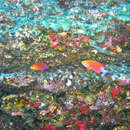tr
kırıntılardaki isimler


Pseudanthias hawaiiensis ist eine kleine Fahnenbarschart, die im nördlichen Zentralpazifik von Hawaii bis zum Johnston-Atoll vorkommt.
Die Fische erreichen eine Standardlänge von etwa 8 cm[1] und haben einen langgestreckten Körper, dessen Standardlänge das 2,6 bis 3-fache der Körperhöhe beträgt. Weibchen sind auf dem Rücken gelblich gefärbt. Die Schuppen der Körperseiten sind lavendelfarben bis pink; ihre Zentren sind aber gelb. Auf dem Kopf zeigen sich verschiedene pink- bis magentafarbene Linien. Die Flossen sind gelblich. Rücken- und Afterflosse haben magentafarbene Ränder. Männchen sind ähnlich gefärbt aber mehr orange als gelb mit rot gefärbten Schuppenzentren an den Körperseiten und violett gefärbten Schuppenzentren an den hinteren Körperseiten. Rücken- und Afterflosse sind vor allem orange gefärbt und am hinteren Ende hellgelb. An der Brustflossenbasis befindet sich ein magentafarbener Fleck. Der Unterkiefer ist beschuppt. Der obere Rand des Präoperculums ist fein gesägt, der untere Rand ist glatt. Die Schwanzflosse ist tief eingeschnitten und die Spitzen sind bei den Männchen ausgezogen. Die Bauchflossen sind lang, sehr lang bei den Männchen.[1][2]
Pseudanthias hawaiiensis lebt in Tiefen von 26 bis 68 Metern sehr versteckt im und über dem Geröll an der Basis von Korallenriffen und ernährt sich von planktonisch lebenden kleinen Krebstieren (vor allem von Copepoden), den Larven von Krebstieren, Borstenwürmern und Weichtieren, sowie von Fischeiern. An der Decke von Höhlen schwimmen sie mit dem Bauch nach oben.[2]
Die Fischart wurde 1979 durch den US-amerikanischer Zoologen John Ernest Randall unter der Bezeichnung Anthias (Pseudanthias) ventralis hawaiiensis erstmals wissenschaftlich beschrieben. In der gleichen Veröffentlichung beschrieb er Anthias (Pseudanthias) ventralis ventralis als zweite Unterart von Anthias (Pseudanthias) ventralis.[2] Eine Beschreibung der gemeinsamen Merkmale beider Unterarten wurde aber nicht veröffentlicht. Pseudanthias gilt heute als eigenständige Gattung und die beiden Unterarten als eigenständige aber nah verwandte Arten (Pseudanthias hawaiiensis und Pseudanthias ventralis[3]).
Pseudanthias hawaiiensis ist eine kleine Fahnenbarschart, die im nördlichen Zentralpazifik von Hawaii bis zum Johnston-Atoll vorkommt.
Pseudanthias hawaiiensis, the Hawaiian longfin anthias, is a small colorful species of fish in the subfamily Anthiinae. It is often treated as a subspecies of P. ventralis,[2] but some authorities prefer to treat them as separate species.[3] It is endemic to reefs at depths of 26–219 m (85–719 ft) in Hawaii and the Johnston Atoll.[3]
It reaches 10 cm (3.9 in) in length and is bright yellow, orange, red and purple.[3] It occasionally makes its way into the aquarium trade, but it is a difficult species to maintain.
Pseudanthias hawaiiensis, the Hawaiian longfin anthias, is a small colorful species of fish in the subfamily Anthiinae. It is often treated as a subspecies of P. ventralis, but some authorities prefer to treat them as separate species. It is endemic to reefs at depths of 26–219 m (85–719 ft) in Hawaii and the Johnston Atoll.
It reaches 10 cm (3.9 in) in length and is bright yellow, orange, red and purple. It occasionally makes its way into the aquarium trade, but it is a difficult species to maintain.